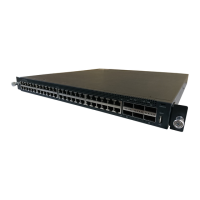FUJITSU PSWITCH User’s Guide
62 December/2018
links connected to the secondary device.
3.1.2.6.3. VPC Limitations
The implementation of the VPC feature is proprietary and is not based on any
standards. The following constraints apply:
The administrator must configure the VPC peers identically.
VPC peer-link transmit data traffic
- In Non-Enhance mode: Data traffic over the VPC peer-link, when the
member ports of the VPC interface are all down on this device.
- In Enhance mode: Data traffic over the VPC peer-link with Non-VPC member
port.
VPC Configuration Limitations
- The VPC interface and peer link must be a port-channel interface, and
port-channel must be dynamic.
- When VPC global status is “Disabled” then peer-link member port admin
state is “Disabled”, on the contrary VPC global status is “Enabled” then
peer-link member port admin state is “Enabled”.
- VPC interface member admin status will “Disable” when port-channel
interface configuration as VPC interface. VPC interface member admin
status will “Enable” when VPC peer-link interface link up.
3.1.2.7. Virtual LAN (IEEE 802.1Q)
802.1Q VLAN is an implementation of the Virtual Local Area Network, specification
802.1Q. Operating at layer 2 of the OSI model, the VLAN is a means of parsing a
single network into logical user groups or organizations as if they physically resided
on a dedicated LAN segment of their own. The VLAN identifier is part of the 802.1Q
tag, which is added to an Ethernet frame by an 802.1Q-compliant switch. Devices
recognizing 802.1Q-tagged frames maintain appropriate tables to track VLANs. The
first 3 bits of the 802.1Q tag are used by 802.1p to establish priority for the packet.
Switch supports 802.1Q VLANs. As such, ports may simultaneously belong to
multiple VLANs. VLANs allow a network to be logically segmented without regard
to the physical locations of devices in the network. Each VLAN has a unique
number, called the VLAN ID. In a tagged frame, the VLAN is identified by the VLAN
ID in the tag. In an untagged frame, the VLAN identifier is the Port VLAN ID (PVID)
specified for the port that received the frame.
VLAN tagging is required when a single port supports multiple devices that are
members of different VLANs. For example, a single port might be connected to an

